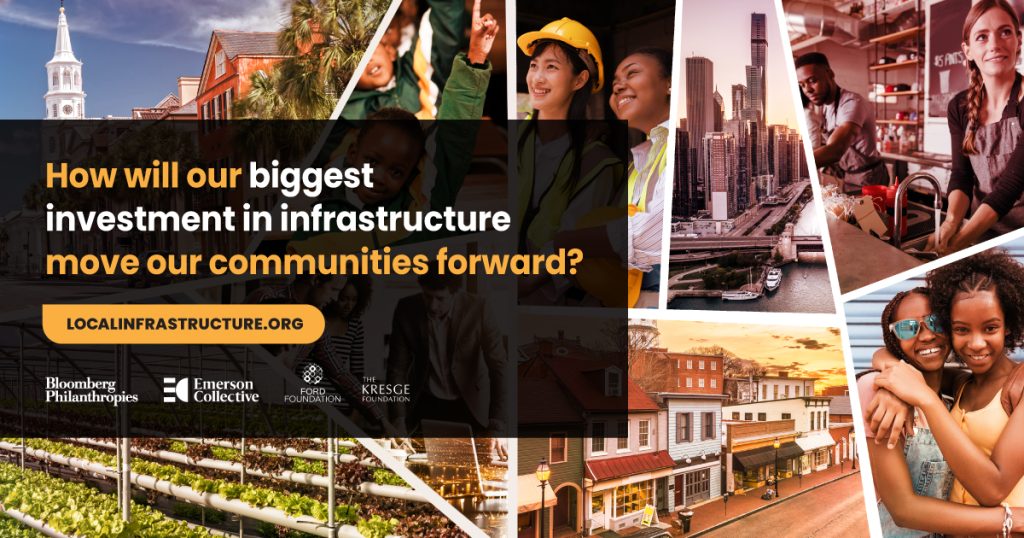
One of the most tangible ways mayors can improve residents’ wellbeing and the overall livability in their cities is by making their transportation systems more reliant, efficient, and safe.
Consider that transportation accounts for more than a quarter of greenhouse gas emissions globally, and is a leading driver of air pollution in cities. Or that traffic fatalities are at a 16-year high in the U.S. Or that spending on transportation consumes 16 percent of household budgets, and often more than that in low-income households struggling with inflation. These are deep problems in need of local innovations.
As part of a set of supports for U.S. cities and towns called the Local Infrastructure Hub, Bloomberg Philanthropies yesterday convened nearly 200 mayors and local leaders to discuss how to address these problems and more with funding from the $1 trillion Bipartisan Infrastructure Law. They heard from key Biden administration officials about how to win grants from a new federal program aimed at upgrading transportation systems. And they learned how three mayors from very different U.S. cities and towns are angling for the money.
The new federal grant program, called Strengthening Mobility and Revolutionizing Transportation (or SMART), provides $100 million a year for the next five years for public-sector agencies to propose new ways of using technology to make transportation more efficient and safe. U.S. cities and towns of all sizes are eligible to apply. The deadline for the first round of SMART grants is Nov. 18.
Federal officials emphasized the historic opportunity for communities to use technology to transform their transportation systems. “When we say ‘transformation,’ that means designing for the future,” said Robert Hampshire, Deputy Assistant Secretary for Research and Technology at the U.S. Department of Transportation (DOT). Hampshire called on local leaders to unleash transportation innovations, particularly when it comes to safety, reducing emissions, improving equity, and strengthening supply chains. “Innovation should help us win the 21st century by future-proofing our infrastructure, enabling adaptability and resilience, and also bringing into the modern era some of the legacy systems into the digital age,” he said.
To encourage innovation, up to 50 “Stage One” grants of up to $2 million will be available this year. Ben Levine, Senior Advisor for Research and Technology at DOT, said these grants will support projects that “will benefit from a planning and prototyping phase that allows them to build partnerships, refine ideas, and initially test the ways that a particular technology innovation will be embedded in their community.” Cities can then come back and apply for a larger “Stage Two” grant of up to $15 million.
Los Angeles Mayor Eric Garcetti encouraged mayors to take a long-term view, noting that successful projects may not be felt until long after they leave office. That will be true of the $120 billion transportation package Los Angeles County voters passed in 2016. “Addressing these problems requires a 10-to-20 year-long vista,” he said. One thing that’s been helpful in L.A., Garcetti said, was to establish an Urban Mobility Lab where companies can test mobility technology in a variety of urban settings. “If you have something you want to do and try,” he said, “you can do it right here in Los Angeles.”
Salt Lake City, Utah, Mayor Erin Mendenhall relayed ways her city is innovating in transportation. An “on-demand” transit pilot that matches people for shared rides to or from transit stations has been a big hit, she said, and is set to expand. The city also is investing in flashing sidewalk beacons to improve pedestrian safety, and utilizing aggregated cell phone data to inform transportation planning. The SMART grants will enable more experimentation, she said. “They’re letting us try new things,” Mendenhall said of DOT. “They’re embracing what’s working and they’re letting us move on from things that don’t work. Cities are invited now to be experimenters and try and try again. That is an exciting and new place for us to be as a city.”
Mayor Travis Stovall of Gresham, Ore., said transportation innovations are critical to lift residents out of poverty. When traffic signals were set to prioritize movement of rapid buses, he said, travel times from Gresham to downtown Portland went down by 20 percent. That opens new opportunities for residents. “The path between poverty and prosperity,” Stovall said, “requires leveraging transportation solutions to get individuals to work and educational opportunities.”
Bloomberg Philanthropies, The Ballmer Group, Emerson Collective, Ford Foundation, and the Kresge Foundation joined together and contributed $55 million to the Local Infrastructure Hub to help local leaders make the most of the historic opportunities in the Bipartisan Infrastructure Law. Technical assistance and learning support through the Local Infrastructure Hub is delivered by the U.S. Conference of Mayors, National League of Cities, and Results for America.
As part of the Local Infrastructure Hub, the National League of Cities has been holding boot camps for local leaders to meet with subject-matter experts and prepare competitive applications for federal grants, including SMART. Many of those boot camp resources are now available to all cities here.
Additional resources for local leaders:
- 5 winning strategies for building competitive SMART applications (Local Infrastructure Hub)
- SMART grants Frequently Asked Questions (US Department of Transportation)